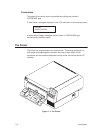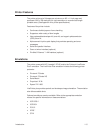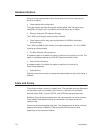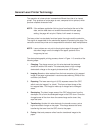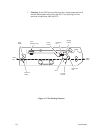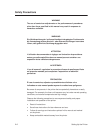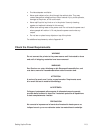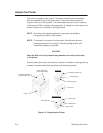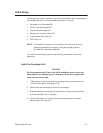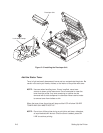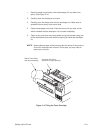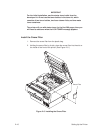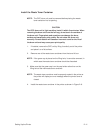
2–4 Setting Up the Printer
The printer must be connected to an acceptable AC power source; otherwise, the
printer will not operate properly and may be damaged. The rear side panel label
identifies the correct power source for the printer: either 100 to 120 VAC, 60 Hz
(90 to 132 VAC, 47 to 63 Hz, 14 Amp) or 220 to 240 VAC, 50 Hz (198 to 264
VAC, 47 to 63 Hz, 7 Amp).
The power source must be properly grounded. Since large power fluctuations can
cause the printer to malfunction, it should be connected to a “noise–free” power
source, not subject to surges or noise generated by motors, lighting, or air
conditioning equipment on the same circuit. To allow for an adequate power
cable run, the printer should be placed no more than eight feet (2.5 meters) from
the power outlet.
Select a Site
When selecting the location for the printer, consider the following power
requirements, interface requirements, and environmental factors:
• A proper power source must be available. (Complete power
requirements are specified in the “Check Power Requirements” section
on page 2–3.)
• The location must be within the maximum cable length specifications for
the host computer interface.
• The temperature range should be +50
°F (10°C) to +90°F (32°C), with no
sudden changes in temperature or humidity. The printer should be
positioned away from any air drafts from heating or air conditioning
ducts.
• Insure that the room provides adequate ventilation. The minimum room
volume is 1000 cubic feet and must provide, at a minimum, one fresh air
exchange every two hours.
• The location should provide enough space for maintenance and
replacement of consumables (toner, developer, paper, etc.). Refer to
Figure 2–1.
• The printer should not be exposed to direct sunlight or hot lighting
equipment. This may cause an abnormal temperature rise in the printer
and adversely affect its operation. If necessary, shade or screen the
printer from such exposure.
• Avoid exposing the printer to any corrosive gases or vapors.
• Avoid installing the printer in an area subject to heavy vibrations.
For additional environmental requirements, refer to the “Introduction” chapter and
to Appendix A
.



